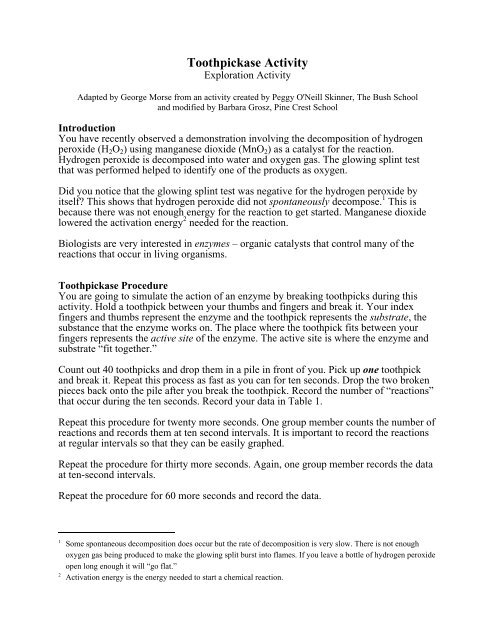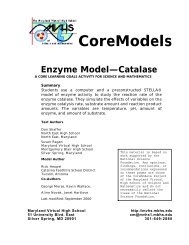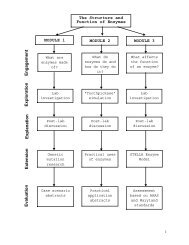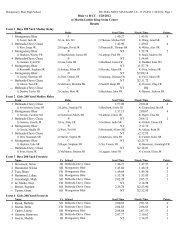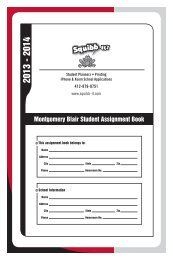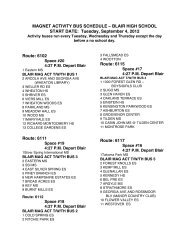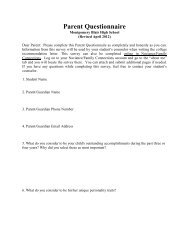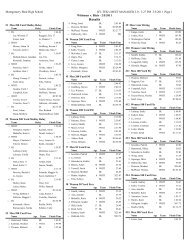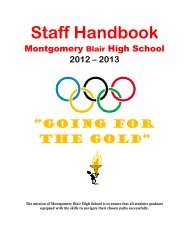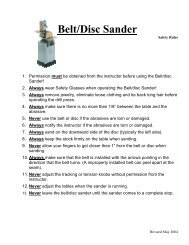Exploration
Exploration
Exploration
You also want an ePaper? Increase the reach of your titles
YUMPU automatically turns print PDFs into web optimized ePapers that Google loves.
Toothpickase Activity<br />
<strong>Exploration</strong> Activity<br />
Adapted by George Morse from an activity created by Peggy O'Neill Skinner, The Bush School<br />
and modified by Barbara Grosz, Pine Crest School<br />
Introduction<br />
You have recently observed a demonstration involving the decomposition of hydrogen<br />
peroxide (H 2 O 2 ) using manganese dioxide (MnO 2 ) as a catalyst for the reaction.<br />
Hydrogen peroxide is decomposed into water and oxygen gas. The glowing splint test<br />
that was performed helped to identify one of the products as oxygen.<br />
Did you notice that the glowing splint test was negative for the hydrogen peroxide by<br />
itself? This shows that hydrogen peroxide did not spontaneously decompose. 1 This is<br />
because there was not enough energy for the reaction to get started. Manganese dioxide<br />
lowered the activation energy 2 needed for the reaction.<br />
Biologists are very interested in enzymes – organic catalysts that control many of the<br />
reactions that occur in living organisms.<br />
Toothpickase Procedure<br />
You are going to simulate the action of an enzyme by breaking toothpicks during this<br />
activity. Hold a toothpick between your thumbs and fingers and break it. Your index<br />
fingers and thumbs represent the enzyme and the toothpick represents the substrate, the<br />
substance that the enzyme works on. The place where the toothpick fits between your<br />
fingers represents the active site of the enzyme. The active site is where the enzyme and<br />
substrate “fit together.”<br />
Count out 40 toothpicks and drop them in a pile in front of you. Pick up one toothpick<br />
and break it. Repeat this process as fast as you can for ten seconds. Drop the two broken<br />
pieces back onto the pile after you break the toothpick. Record the number of “reactions”<br />
that occur during the ten seconds. Record your data in Table 1.<br />
Repeat this procedure for twenty more seconds. One group member counts the number of<br />
reactions and records them at ten second intervals. It is important to record the reactions<br />
at regular intervals so that they can be easily graphed.<br />
Repeat the procedure for thirty more seconds. Again, one group member records the data<br />
at ten-second intervals.<br />
Repeat the procedure for 60 more seconds and record the data.<br />
1<br />
Some spontaneous decomposition does occur but the rate of decomposition is very slow. There is not enough<br />
oxygen gas being produced to make the glowing split burst into flames. If you leave a bottle of hydrogen peroxide<br />
open long enough it will “go flat.”<br />
2<br />
Activation energy is the energy needed to start a chemical reaction.
Table 1: This is a data table for recording the number of reactions in 10-second intervals.<br />
Time<br />
(seconds)<br />
Number of<br />
Reactions<br />
Time<br />
(seconds)<br />
Number of<br />
Reactions<br />
Time<br />
(seconds)<br />
Number of<br />
Reactions<br />
10 50 90<br />
20 60 100<br />
30 70 110<br />
40 80 120<br />
Figure 1:<br />
Analysis<br />
1. Write an appropriate title in the space next to “Figure 1.” Plot a graph of the number<br />
of reactions verses time. Draw the curve that best conforms to the data. Label each<br />
axis of the graph.<br />
2. Summarize Figure 1. What inferences can you make about enzyme reaction rate?<br />
3. What do you think would happen to the reaction rate if the toothpicks were spread out<br />
so that the “enzyme” has to reach for them?<br />
4. What do you think would happen to the reaction rate if the number of toothpicks were<br />
doubled? Use a colored pencil to draw a second curve on Figure 1 to describe your<br />
prediction.<br />
5. What do you think would happen to the reaction rate if two students break toothpicks<br />
instead of one?


